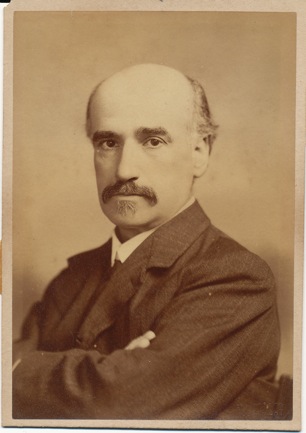John Davidson
(1857 – 1909)
John Davidson is best known for a poem in the July 1894 Yellow Book (Vol. II)— “ Thirty Bob a Week.” Its fame partly derives from the warm accolade of T. S. Eliot in the preface to a 1961 selection of Davidson’s poetry (ed. Maurice Lindsay): “Davidson had a great theme, and also found an idiom which elicited the greatness of the theme, which endowed this thirty-bob-a-week clerk with a dignity that would not have appeared if a more conventional poetic diction had been employed. The personage that Davidson created in this poem has haunted me all my life, the poem is to me a great poem for ever” (vii).
“Thirty Bob,” its successor “ A Ballad of a Nun” ( The Yellow Book Vol III, October 1894), and Ballads and Songs (John Lane: The Bodley Head, 1894) made Davidson’s name in the 1890s. But his fame was short-lived. None of his volumes after 1894 sold as well or attracted the same lively following as Ballads and Songs, and Davidson suffered increasingly from health problems. Penurious and marginalized, Davidson had a whiskey and cigar on the evening of 23 March 1909 in Penzance and left a note declaring his intent to make an end; his body was not found until six months later.
His sad end chimes with his life-long status as an outsider. Born in Barrhead, Renfrewshire, Scotland, Davidson moved with his family to the industrial port city of Greenock on the Firth of Clyde at age nine. In contrast to his father, an Evangelical Union preacher, Davidson renounced Christianity. Surrounded by industry, Davidson was drawn to poetry and whiled away Sunday afternoons writing blank verse. An effective teacher of English in Scottish preparatory schools (1877-1889), he found no joy in the work.
By 1890, when he moved to London to pursue a literary career, he was the married father of two sons. He had met Algernon Swinburne (1837-1909) (in 1878 and John Barlas (1860-1914) in 1886. He had also gained recognition for his poetry and plays, including Scaramouch at Naxos (1889), reprinted in Plays ( Elkin Mathews and John Lane, 1894) with a frontispiece by Aubrey Beardsley (1872-1898). In London he found steady work in journalism, publishing one of the earliest essays on Nietzsche ( Speaker, 28 November 1891), as well as numerous reviews, and quickly entered circles associated with aestheticism and decadence. Here too he felt something of an outsider and, though he met with the Rhymers’ Club, refused to contribute poems to its two anthologies.
In 1896, at the peak of his prominence, he suffered a breakdown and never fully recovered his momentum or standing. Increasingly dedicated to the philosophy of Nietzsche, he wrote a series of blank verse “testaments” expounding materialist philosophy and the will to power, but these attracted no following. Depression and illness helped hasten his death. He has been claimed as an ironist, existentialist, and Nietzschean; but his poetry’s realism, mobile rhythms, and expansive idiom are his greatest literary contributions.
© 2010, Linda K. Hughes
Linda K. Hughes is Addie Levy Professor of Literature at Texas Christian University, Fort Worth. She is the author of Graham R.: Rosamund Marriott Watson, Woman of Letters (2005), The Cambridge Introduction to Victorian Poetry (2010), and numerous essays on the literature and culture of the 1890s in essay collections and in Victorian Poetry, Victorian Periodicals Review, SEL: Studies in English Literature, Victorian Literature and Culture, and Philological Quarterly .
Selected Publications by Davidson
- Ballads and Songs. London: John Lane The Bodley Head, 1894.
- Fleet Street Eclogues. London: Elkin Mathews and John Lane, 1893.
- The Last Ballad and Other Poems. London: John Lane The Bodley Head, 1899.
- New Ballads. London: John Lane The Bodley Head, 1897.
- A Random Itinerary. London: Elkin Mathews and John Lane, 1894.
- A Second Series of Fleet Street Eclogues. London: John Lane The Bodley Head, 1896.
- The Testament of an Empire-Builder. London: Richards, 1902.
Selected Publications about Davidson
- Austin, Linda M. “Aesthetic Embarrassment: The Reversion to the Picturesque in Nineteenth Century English Tourism.” ELH 74.3 (2007): 629-53.
- Eliot, T. S. Preface. John Davidson: A Collection of His Poems . Ed. Maurice Lindsay. London: Hutchinson, 1961.
- Hughes, Linda K. “Ironizing Prosody in John Davidson’s ‘A Ballad in Blank Verse.’” Victorian Poetry, Special issue on Victorian Prosody, ed. Yisrael Levin and Meredith Martin, forthcoming.
- Hynd, Hazel. “A Sense of Place: Landscape and Location in the Poetry of John Davidson.” Victorian Poetry 43.4 (2005): 497-512.
- Peterson, Carroll V. John Davidson. New York: Twayne, 1972.
- Schäffner, Raimund. “‘Better to reign in Hell than serve in Heaven’: Aspects of Social Darwinism in John Davidson’s Poetry.” Journal of European Studies 33.2 (2003): 119-44.
- Sloan, John. John Davidson, First of the Moderns: A Literary Biography . Oxford: Clarendon Press, 1995.
- Townsend, J. Benjamin. John Davidson: Poet of Armageddon . New Haven: Yale University Press, 1961.
MLA citation:
Hughes, Linda K. “John Davidson (1857-1909),” Y90s Biographies, 2010. Yellow Nineties 2.0, edited by Lorraine Janzen Kooistra, Ryerson University Centre for Digital Humanities, 2019, https://1890s.ca/davidson_bio./
